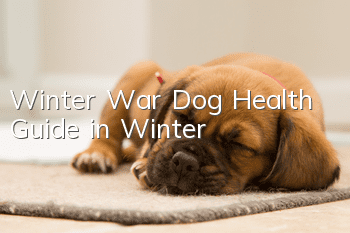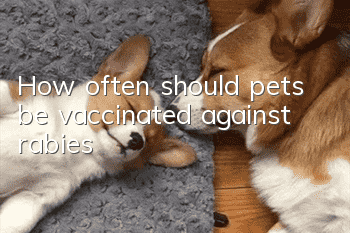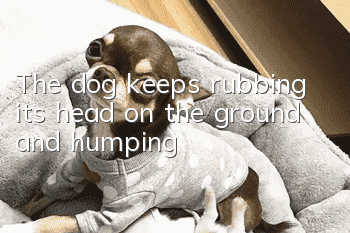Winter War: Dog Health Guide in Winter

Winter is coming with its cold wind and cold snow. In this dry and cold winter, have you prepared your dog for the winter? In winter, dogs also need to keep warm from the cold and enhance their resistance!
1. How to take care of your dog in winter
The harsh winter has arrived. What special attention do dogs need? Can their bodies survive the winter safely? In fact, they also need a regimen of health care.
1. The weather in winter is cold and dry, and the dog's blood circulation is prone to be poor. The joint tissue cannot drain blood with the change of temperature, causing joint pain and swelling. Therefore, keeping warm is the key to protecting joints.
2. Protect the respiratory tract. The large temperature difference between morning and evening makes dogs with sensitive trachea prone to respiratory diseases, coughs, colds, fevers and other diseases. When the weather is cold, it is key to add more water to your dog and improve its resistance.
3. Protect eyes. Although bacteria are less likely to breed in winter, dog eye diseases will not decrease depending on the season. Therefore, parents should pay attention to the health of their dogs’ eyes all year round and not take it lightly.
4. Protect the soles of your feet in the winter when snowflakes are flying and the ground is freezing. In winter, the paws and pads of dogs are also relatively fragile and prone to dryness, cracking and peeling. Parents should pay attention to protecting the dog's paws when taking their dogs out for activities.
2. Tips for keeping warm in winter
Dogs need more careful care and concern from their parents in the cold winter. Dogs will also shiver due to the cold, and they also need to be protected from the cold and kept warm. Therefore, parents, start now to give your dogs a warm winter!
1. Prevent colds
The arrival of winter makes the weather dry and cold. During this period, dogs need to prevent respiratory diseases, colds and other diseases. Especially small dogs and puppies have poor cold tolerance and resistance, and are more likely to get sick in winter!
2. Supplement nutrition
Supplementing dog nutrition in winter is the first priority. Only by absorbing enough nutrients can the dog be stronger and have stronger cold resistance.
3. Keep moving
Although winter is very cold and outdoor activities have been reduced, it is essential to go out and exercise every day. Because increasing exercise for dogs is also an important way to improve immunity.
4. No need for major supplementation
Winter is a good time to take supplements. Parents will also consider adding extra meals to their dogs or feeding them something more nutritious.West. In fact, it is not necessary, as it will increase the burden on the dog's body, as long as you follow the normal feeding method every day. However, it is okay to encourage your dog by feeding him small snacks occasionally.
3. Clothes suitable for dogs in winter
Long-haired dogs don’t need to wear clothes: Dogs are not very cold-sensitive animals, and the surface defenses of most dogs’ bodies are enough to withstand the cold in winter. Some dogs have very long and thick hair, such as many shepherd dogs, long-haired dogs or sled dogs. Not only do they have thick hair, but they also grow a thick undercoat in winter. It is completely difficult to wear clothes for such dogs. It's necessary.
Short-haired dogs that are strong or prone to obesity do not need to wear clothes: Wearing clothes for dogs in winter is more targeted at short-haired dogs. However, even if your dog has short hair, it is not 100% necessary to wear clothes for him. Dogs that are easy to gain weight, such as mynas, bulldogs, short-haired dachshunds, etc., do not necessarily need to wear clothes in winter. Their body fat is enough. Clothes for such dogs can sometimes affect them. exercise. For dogs with very strong bodies, such as spots, Labradors, Great Danes, Rottweilers, etc., there is no need to wear clothes to resist the cold in winter, because they are very strong, and excessive protection will reduce their resistance. force.
Dogs with short hair and thin bodies should wear clothes in winter: although most dogs are not afraid of the cold, some breeds born as toy dogs are still very weak. The most obvious example is the Chihuahua. This kind of miniature dog is very thin and has no protection from thick fur. It is born as a child growing up in a greenhouse. When the cool breeze blows in autumn, they will shiver when they go out. Yes, and because this kind of dog is thin, it is easy to get more serious if it is sick. It is very beneficial for this kind of dog to wear clothes when the weather is cold. If your dog is not a Chihuahua, but it has the following characteristics: thin, short hair, and poor physical fitness, it is best to consider buying them some small clothes to protect them from the cold when winter comes. Generally speaking, most dogs do not need to wear clothes in winter. Of course, if your dog is very cute in clothes and you really want it to show off in small clothes, you might as well let it wear clothes and go out for a walk occasionally, but just occasionally, it doesn’t have to be like this every day, so as to save the little one from wearing clothes. I'm used to wearing clothes. One cold day I went out without clothes and came back with a cold.
Theoretically, dogs do not need to wear clothes, and most dogs (especially long-haired dogs) can spend the winter outdoors. Of course, they also need a den. Nowadays, because dogs live indoors for a long time and under the careful care of their owners, their body's resistance and ability to keep out the cold have declined. Therefore, they need to wear some clothes to help them resist the cold outside, but they don't need to be too thick for a long time. Wearing clothes is also not good for your dog’s fur, as long asJust put it on before going out! If some small dogs have been kept and slept indoors, and the temperature outside is more than 25 degrees Celsius different from the indoor temperature, it is best to put clothes on them when going out for a walk.
IV. Things to pay attention to when dogs go out in winter
1. Choose a time period with higher temperatures, such as 12:00 to 15:00;
2. If the area has started to be heated and the temperature difference between indoors and outdoors is large, it is best to put some clothes on the puppy when going out in the morning and evening;
3. Try to let the puppy have a gradual adaptation process from going out to the outdoors, such as staying in the corridor for a while;
4. Always keep your dog on a leash when going out to prevent naughty puppies from getting lost, eating roadside food and getting into car accidents;
5. Don’t forget to clean up the dog’s feces in time and keep the walking area clean;
6. It is not easy to take more baths in winter. After returning home from a walk, use a hot towel to wash the puppy's face, lower abdomen, buttocks, 4 paws and tail.
5. Things to pay attention to when exercising with dogs in winter
1. Keep exercising and maintain adequate time for exercise and play.
2. Remember not to exercise after your dog is full, as it may cause digestive problems.
3. Try to avoid letting the dog exercise before and after feeding.
4. Jogging, walking, climbing or playing Frisbee games with your dog can help your dog strengthen their physical fitness and help them control their weight in winter to prevent them from getting fat.
5. When going out for exercise, you should pay attention to keeping out the cold. Short-haired dogs and dogs with health problems can wear cold-proof clothing made of thicker materials when going out.
- How to treat bad breath in Alaskan dogs? Come and take a look!
- Causes of discoloration of dogs’ noses
- How to treat conjunctivitis in dogs?
- What training does the American Water Spaniel need?
- How big do Teddy dogs usually grow?
- Which dog is the smartest and easiest to train? Do you have a dog at home?
- Is it okay if my dog’s nails bleed after being clipped?
- Artois Hound breeding methods and appearance characteristics
- What to do if Gu Mu vomits
- Why does a dog that has been owned for a long time become aggressive towards its owner?



